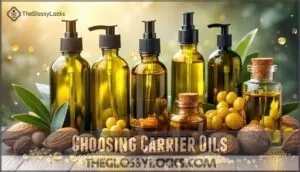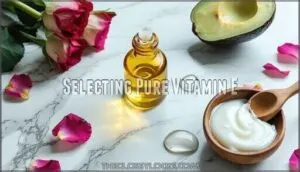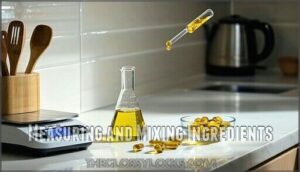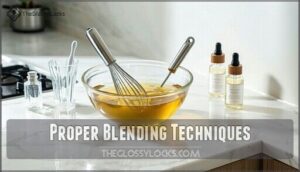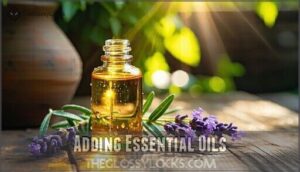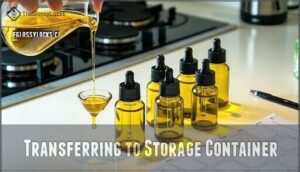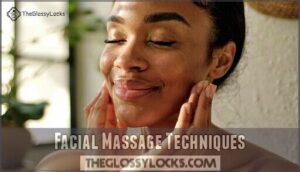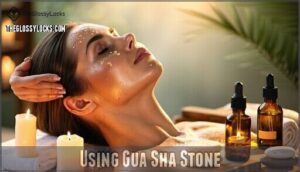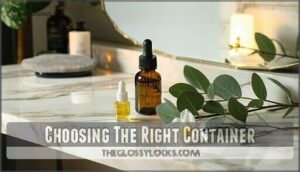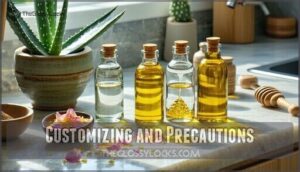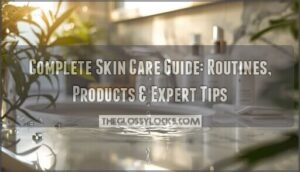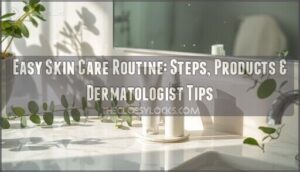This site is supported by our readers. We may earn a commission, at no cost to you, if you purchase through links.
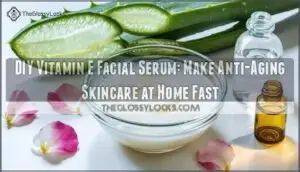 Creating your own DIY vitamin E facial serum is surprisingly simple and costs a fraction of store-bought alternatives.
Creating your own DIY vitamin E facial serum is surprisingly simple and costs a fraction of store-bought alternatives.
You’ll need just four ingredients: 2 tablespoons each of aloe vera gel and rose water, plus 2 tablespoons vitamin E oil and 1 teaspoon argan oil.
Mix the aloe and rose water first until smooth, then blend in the oils until everything’s perfectly combined.
This powerhouse serum delivers antioxidant protection while boosting skin regeneration and fighting signs of aging.
The best part is that you control exactly what goes on your face, avoiding harsh chemicals and mystery ingredients.
But choosing the right carrier oils for your specific skin type makes all the difference.
Table Of Contents
- Key Takeaways
- Benefits of Vitamin E Serum
- Choosing Carrier Oils
- Selecting Pure Vitamin E
- Making Vitamin E Serum
- Application and Storage
- Customizing and Precautions
- Frequently Asked Questions (FAQs)
- How to make vitamin E serum for face?
- What should I mix with vitamin E for my face?
- How to get vitamin E naturally for face?
- What is the best homemade serum for face?
- Can you use vitamin E as a face serum?
- Can I put 100% vitamin E on my face?
- Can vitamin E serum be used on all skin types?
- How long does a homemade vitamin E serum last?
- Can I mix vitamin E with other skincare products?
- What are the signs that a vitamin E serum is not working?
- Conclusion
Key Takeaways
- Choose the right carrier oil for your skin type – You will get better results by matching oils to your needs: jojoba for oily skin, rosehip for dry skin, hemp seed for combination skin, and almond oil for sensitive skin.
- Use proper ratios and quality ingredients – You will want natural vitamin E (d-alpha-tocopherol) mixed at a 10:1 ratio with your carrier oil, avoiding synthetic versions that do not absorb as well or provide the same antioxidant benefits.
- Store correctly to maintain potency – You will need amber glass containers with airtight seals stored away from sunlight to prevent oxidation and extend your serum’s shelf life to 6-12 months.
- Apply strategically and watch for reactions – You will see the best results using the serum 2-3 times weekly during your nighttime routine, but discontinue immediately if you experience irritation, redness, or breakouts.
Benefits of Vitamin E Serum
You’ll love how vitamin E serum transforms your skin with powerful antioxidants that fight free radicals and environmental damage better than most store-bought products.
This simple DIY recipe delivers anti-aging benefits, reduces inflammation, and boosts cell regeneration while saving you money on expensive skincare.
Antioxidant Protection
Your DIY vitamin e serum acts like a protective shield against free radical damage from environmental pollutants and UV rays.
These powerful antioxidants strengthen your skin barrier while preventing collagen degradation that leads to wrinkles.
Think of vitamin e benefits as your skin’s personal bodyguard, neutralizing harmful molecules before they can damage healthy cells in your facial serum, providing a natural way to maintain skin health with antioxidants.
Vitamin E works like your skin’s personal bodyguard against daily damage.
Skin Cell Regeneration
Your vitamin e serum kicks skin cell turnover into high gear, speeding up collagen production and wound healing.
This epidermal rejuvenation process helps fade scars while your diy skincare works overtime repairing damage.
Studies show this antiaging serum boosts cell regeneration, giving you fresher skin that bounces back faster from daily wear and tear.
It can also improve the skin’s barrier, beneficial for eczema, which is a key aspect of maintaining healthy skin cell turnover.
Anti-inflammatory Properties
When skin inflammation strikes like an unwelcome guest, your DIY vitamin E serum acts as a gentle bouncer.
This powerhouse ingredient reduces redness reduction while providing eczema relief and acne treatment benefits.
The antioxidants in your homemade antiaging serum calm irritated skin, promoting wound healing and irritation soothing.
Your DIY skincare creation tackles skin inflammation naturally, making angry skin behave with the help of antioxidants.
Anti-aging Effects
Time turns back the clock when you harness vitamin E’s collagen boosting power in your DIY skincare routine.
This antiaging superstar tackles wrinkle reduction while improving skin elasticity through enhanced cell turnover and UV protection.
Your vitamin e serum delivers these anti-aging benefits:
- Collagen production – Stimulates fibroblasts for firmer skin
- Free radical defense – Shields against environmental damage
- Fine line smoothing – Reduces visible signs of aging
- Cellular renewal – Accelerates healthy skin regeneration
Moisturizing and Nourishing
Everyone deserves that dewy, plump glow that screams healthy skin.
Your homemade serum delivers serious hydration boost while strengthening your lipid barrier. The vitamin e serum works like a moisture magnet, improving skin softness through enhanced nutrient delivery.
This facial serum recipe creates cell plumping effects that’ll make your complexion look refreshed and nourished naturally, providing a serious hydration boost.
Choosing Carrier Oils
You’ll need a carrier oil that matches your skin’s needs since it makes up most of your serum formula.
The right carrier oil acts as the perfect delivery system for vitamin E while addressing your specific skin concerns.
Jojoba Oil for Oily Skin
Despite popular belief, jojoba oil won’t clog your pores—it’s nature’s perfect mimic of your skin’s natural oils.
Nature designed jojoba to perfectly match your skin’s sebum – zero pore-clogging drama.
This non-comedogenic powerhouse delivers lightweight hydration without triggering breakouts, making it ideal for your DIY vitamin e serum.
Jojoba Benefits for oily skin:
- Regulates sebum control naturally
- Absorbs quickly without residue
- Balances oil production over time
- Perfect base for facial serum recipe
- Supports effective oil cleansing
Rosehip Oil for Dry Skin
For dry skin that drinks up moisture like a desert soaks up rain, rosehip oil delivers intense hydration through cold-pressed extraction methods.
This vitamin e serum base offers superior rosehip benefits including scar reduction and deep skin hydration.
Your DIY facial serum gains powerhouse nourishment when you blend this facial oil blend with vitamin e oil.
| Property | Benefit | Best For |
|---|---|---|
| Vitamin A & C | Skin repair | Mature skin |
| Essential fatty acids | Deep hydration | Flaky patches |
| Antioxidants | Scar reduction | Damaged areas |
| Lightweight texture | Quick absorption | Daily use |
Hemp Seed Oil for Combination Skin
Hemp seed oil works like a charm for combination skin’s tricky needs.
This DIY serum ingredient brings balanced fatty acid profile that won’t clog pores thanks to its non-comedogenic properties.
You’ll love how hemp oil benefits include managing both oily and dry zones.
Balancing oil production is a key strategy for this skin type.
Choose cold-pressed hemp oil source for your vitamin E oil blend – it delivers superior skin hydration serum results, which is a great benefit of using hemp seed oil for skin hydration serum.
Almond Oil for Sensitive Skin
Why struggle with reactive skin when almond oil offers gentle relief? This mild carrier oil delivers exceptional almond oil benefits for sensitive skin types, providing natural irritation reduction without harsh chemicals.
Its hypoallergenic properties make safe application worry-free in DIY recipes. Discover more about almond oil products for sensitive skin.
Perfect for vitamin E skin hydration serum, this DIY beauty staple creates soothing facial serum ingredients that calm inflammation while nourishing delicate complexions in your DIY facial treatment, utilizing the hypoallergenic properties of almond oil for sensitive skin.
Grapeseed Oil for Acne-Prone Skin
Grapeseed oil cuts through the confusion of acne-prone skincare with its lightweight hydration that won’t clog pores.
This facial oil delivers vitamin E oil benefits while supporting oil cleansing and scar treatment.
Key grapeseed benefits for your facial serum ingredients:
- Non-comedogenic formula – Won’t block pores like heavier oils
- Natural acne reduction – Contains linoleic acid that balances sebum
- Quick absorption – Lightweight texture perfect for oily skin
- Antioxidant protection – Vitamin E for skin repair and healing
Selecting Pure Vitamin E
You’ll want to look for natural vitamin E (marked with a "D" prefix) rather than synthetic versions since it’s more effective for skin benefits.
Check that your vitamin E oil is pure and unrefined—this means it keeps all the good stuff that helps your skin without unnecessary additives that might cause irritation, making natural versions preferable.
Choosing Quality Vitamin E
When choosing vitamin E for your facial serum, look for "d-alpha-tocopherol" on labels rather than "dl-alpha-tocopherol" – that "d" makes all the difference between natural and synthetic forms.
Natural vitamin E absorbs better and packs more antioxidant punch for your skin.
Check that your source lists tocopherol types clearly and offers transparency about extraction methods. Unrefined benefits shine through when you pick cold-pressed, organic options.
Vitamin E’s primary function is preventing UV-induced damage through its antioxidant properties.
Evaluating Oil Purity Levels
You’ll want to check oil purity before mixing your vitamin E facial serum. Pure tocopherol should hit 95% or higher for best results. Lower-grade oils often contain fillers that can irritate sensitive skin.
- Extraction methods: Cold-pressed oils retain more natural compounds than heat-processed versions
- Refining processes: Minimal processing preserves beneficial properties in vitamin E for skin applications
- Additives presence: Watch for synthetic fillers or carrier oils that dilute the active ingredient
- Organic certification: Third-party verification guarantees cleaner facial oil without pesticide residues
- Source transparency: Reputable suppliers provide certificates showing exact purity percentages for their facial serum ingredients
Identifying Trusted Oil Sources
Source your vitamin E from reputable suppliers who provide Organic Certifications and transparent Extraction Methods.
Look for companies that conduct regular Purity Testing and offer complete Ingredient Transparency about their vitamin E for skin products.
Read customer reviews and verify third-party lab results before purchasing your serum for face ingredients.
Quality suppliers openly share their facial serum vitamin E benefits and processing standards, including the importance of Purity Testing and Ingredient Transparency.
Making Vitamin E Serum
Now you’ll create your vitamin E serum using simple measurements and basic mixing techniques.
Start with a clean workspace and sterilized glass dropper bottle, then combine your chosen carrier oil with pure vitamin E using a 10:1 ratio for maximum potency.
Measuring and Mixing Ingredients
Now you’ll measure out your chosen oils with precision – getting the Oil Ratios right is like baking the perfect cookie.
Start with your carrier oil at room temperature for better Ingredient Quality and Vitamin E Potency retention.
- Measure carrier oil first – Use 10ml as your base amount for easy math
- Add vitamin E carefully – Count 2-4 capsules (200-400IU) for ideal antioxidant properties
- Follow proper Blending Order – Always add vitamin E to carrier oil, not vice versa
Temperature Control matters here since heat degrades those precious skincare ingredients you’re working with.
Proper Blending Techniques
Once you’ve measured your ingredients, blend them using gentle circular motions.
Start with room temperature oils for better mixing—cold ingredients won’t play nice together.
Vitamin E’s antioxidant properties shine when properly emulsified through slow, steady stirring.
To boost the anti-aging effects, consider incorporating ingredients that stimulate collagen synthesis.
This mixing order prevents clumping while maintaining the serum’s skincare formulation integrity for your homemade facial serum, ensuring a quality homemade facial serum.
Adding Essential Oils
Once your carrier oil and vitamin E blend perfectly, you can enhance your DIY skincare with carefully chosen essential oils.
The scent profile and therapeutic benefits depend on proper blending ratios and oil synergy considerations.
Here’s your essential oil game plan:
- Start small – Add 2-3 drops per ounce of serum to test safety concerns
- Match your skin type – Lavender for sensitive skin, tea tree for acne-prone areas
- Blend gently – Stir clockwise to maintain the facial serum’s vitamin E potency
Remember, less is more with essential oils in skincare formulations.
For example, jojoba oil benefits include mimicking natural skin oil.
Transferring to Storage Container
Once you’ve mixed your essential oils, carefully transfer your DIY skincare blend using a small funnel into amber glass containers with airtight seals.
This container material protects your vitamin E facial serum from light degradation while proper labeling practices help track your skincare formulation’s shelf life—typically six months for homemade cosmetic formulation.
These containers are ideal because they offer superior UV protection, which is a key factor in maintaining the quality of your DIY skincare products, making proper labeling practices essential for tracking shelf life.
Application and Storage
Now that you’ve crafted your vitamin E serum, proper application and storage will maximize its effectiveness and shelf life.
The way you apply the serum and store it makes all the difference between getting amazing results and watching your hard work go to waste.
Facial Massage Techniques
Gentle movements release facial serum benefits through targeted lymphatic drainage and acupressure points.
Apply your vitamin E skincare using upward strokes from chin to temples, focusing on muscle relaxation.
Press key facial treatments points like the temples and jaw for enhanced circulation.
This facial care tips approach maximizes absorption while preparing skin for tool integration techniques, utilizing facial serum benefits.
Using Gua Sha Stone
Amplify your vitamin E skincare routine with a Gua Sha stone for enhanced serum absorption.
Hold the stone at a 15-45° angle, gliding upward along your jawline and cheeks with light pressure.
This gua sha technique boosts facial contouring while promoting lymphatic drainage.
The stone material creates perfect glide for skin rejuvenation and antiageing benefits through improved skin hydration.
Incorporating Into Skincare Routine
Apply your DIY vitamin E facial serum twice weekly during your night routine for best results.
Layer it after cleansing but before heavier moisturizers—think of it as your skin’s antioxidant bodyguard.
Always follow with sunscreen during morning routines since vitamin E can increase photosensitivity.
Practice skin cycling by alternating serum frequency with other active ingredients for maximum absorption.
Choosing The Right Container
Your vitamin E facial serum needs the right home.
Amber glass bottles protect against light damage, while airtight seals prevent oxidation.
Size matters—choose 15-30ml containers for fresh batches.
Rollerballs offer mess-free application, but droppers give better control for DIY facial care.
Dark glass beats clear plastic every time for preserving your skincare investment, and it is essential to use airtight seals.
Proper Storage Conditions
Store your DIY vitamin E serum in airtight containers made of dark glass to prevent oxidation.
Keep it away from sunlight exposure and maintain cool temperature control around room temperature.
This protects antioxidants from degrading and extends shelf life to 6-12 months.
Your skincare formulation stays potent longer with proper storage practices.
Customizing and Precautions
You’ll want to tweak your serum recipe based on your skin’s unique needs.
You’ll be watching for any reactions along the way, and think of this as fine-tuning your homemade skincare—a little adjustment here and there can make all the difference.
This difference can be between glowing skin and a breakout disaster.
Adjusting Oil Ratios for Skin Type
Customizing your facial serum DIY blend means matching oil ratios to your skin’s unique needs.
Think of it like fine-tuning a recipe—too much of one ingredient throws everything off balance.
- Oily Skin: Use 70% lightweight oils (jojoba, grapeseed) with 30% vitamin E oil skincare blend
- Dry Skin: Mix 60% nourishing oils (rosehip, almond) with 40% vitamin E for deep moisture
- Combination Skin: Balance 50% hemp seed oil with 50% vitamin E oil for even coverage
- Sensitive Skin: Stick to 80% gentle almond oil with 20% vitamin E to avoid irritation
- Acne Prone: Choose 75% non-comedogenic oils (jojoba, grapeseed) in your skincare formulation
Adding Complementary Ingredients
Boost your DIY facial serum’s power by mixing vitamin E with complementary antioxidants.
Hyaluronic Acid increases absorption by 40%, while Vitamin C amplifies photoprotection up to 8 times.
Essential Oils like lavender calm irritation, and herbal extracts such as green tea neutralize 90% of free radicals.
These natural ingredients transform basic serums into targeted skincare treatments with the help of antioxidants.
Seasonal Variations in Formula
Your skin’s needs shift with the weather, so smart DIY skincare recipes adapt accordingly. Winter dryness calls for heavier oils like avocado, while summer humidity works better with lightweight jojoba. Your facial serum should match nature’s rhythm.
Adjust your vitamin E formula seasonally:
- Winter formulas – Add 25% more heavy oils to combat harsh conditions and strengthen your skin barrier against cold air
- Summer blends – Switch to fast-absorbing oils that won’t clog pores when heat increases sebum production by 20%
- Spring adjustments – Include hypoallergenic carriers like hemp oil to reduce irritation during allergy season, plus extra antioxidants for UV protection
Fall exfoliation season means your serum can handle slightly stronger concentrations since dead skin cells naturally shed more.
Avoiding Sun Exposure With Citrus Oils
Citrus oils like lemon or bergamot create citrus photosensitivity, making your skin burn easier in sunlight.
Skip these oils in morning vitamin E facial serum applications or pair with broad-spectrum sunscreen. Evening application timing works best for citrus-infused serums.
Consider oil alternatives like chamomile for daytime antioxidants without UV protection risks.
To further protect your skin, remember to use sunscreen, even on cloudy days, because UV rays penetrate clouds, and always opt for broad-spectrum sunscreen.
Discontinuing Use if Irritation Occurs
If your DIY facial serum causes redness, burning, or breakouts, stop using it immediately.
Patch testing prevents most Allergic Reactions, but some natural ingredients still trigger skin irritation.
Try Alternative Oils like jojoba instead of hemp seed oil.
If Irritation Symptoms persist after discontinuing your Vitamin E serum, Seek Dermatologist advice for proper skincare guidance.
Frequently Asked Questions (FAQs)
How to make vitamin E serum for face?
Like a recipe for skin magic, you’ll combine 10mL carrier oil (jojoba or argan) with 2-4 vitamin E capsules.
Mix well, store in amber glass, and apply nightly for antioxidant protection.
What should I mix with vitamin E for my face?
You’ll want to combine vitamin E with carrier oils like jojoba, argan, or sweet almond oil at 5-5% concentration.
These oils boost absorption and prevent irritation while maximizing vitamin E’s antioxidant benefits.
How to get vitamin E naturally for face?
You’ll find vitamin E naturally in wheatgerm oil, sunflower oil, and sweet almond oil. These carrier oils contain natural tocopherols that’ll nourish your skin without needing synthetic supplements or capsules.
What is the best homemade serum for face?
You’ll love a vitamin E serum that’s gentle yet effective. Mix 10mL jojoba oil with 2-4 vitamin E capsules for antioxidant protection that fights aging and boosts moisture naturally.
Can you use vitamin E as a face serum?
Controlled trials show topical vitamin E can reduce hyperpigmentation by 30% after 12 weeks.
You can absolutely use pure vitamin E as a face serum, though it’s best mixed with carrier oils like jojoba at 5-5% concentration for ideal absorption.
Can I put 100% vitamin E on my face?
You shouldn’t apply 100% pure vitamin E directly to your face. It’s too concentrated and can cause irritation, clogged pores, or allergic reactions. Always dilute it with a carrier oil first.
Can vitamin E serum be used on all skin types?
Like a chameleon adapting to different environments, vitamin E serum works well for most skin types.
But you’ll want to start with lower concentrations. Sensitive skin may react, so patch-test first and avoid overuse above 5%.
How long does a homemade vitamin E serum last?
Your homemade vitamin E serum typically lasts 6-12 months when stored in airtight, amber glass containers away from sunlight. Without preservatives, it’s risky after 4 weeks due to contamination.
Can I mix vitamin E with other skincare products?
You’re basically turning your skincare routine into a power-packed team. Mix vitamin E with moisturizers, serums, or sunscreens—it’ll boost their antioxidant punch and help them work even better together.
What are the signs that a vitamin E serum is not working?
You’ll notice irritation, redness, or breakouts instead of improvement. If there’s no change in skin texture or moisture after 2-4 weeks, it’s likely not effective for you.
Conclusion
Like Cleopatra discovering the fountain of youth, you’ve discovered the secret to radiant skin with your homemade DIY vitamin E facial serum.
This budget-friendly alternative delivers powerful antioxidants without breaking the bank or exposing your skin to harsh chemicals.
Remember to patch test first, store properly in dark containers, and adjust carrier oils based on your skin’s needs.
Your complexion will thank you for this nourishing treatment that rivals expensive store-bought options.
- https://www.youtube.com/diyprojectswithpete?sub_confirmation=1
- https://www.instagram.com/diypete/
- https://twitter.com/intent/tweet?url=https%3A%2F%2Fformulabotanica.com%2F%3Fp%3D5162&text=Vitamin%20E%2C%20common%20in%20skincare%20but%20there%27s%20a%20lot%20to%20learn%20about%20its%20amazing%20active%20properties.%20Try%20out%20%20this%20high-performance%20vitamin%20E%20face%20serum%20formulation.%20%23vitaminE%20%23faceserum%20%23cosmeticformulation&via=FormulaBotanica&related=FormulaBotanica
- https://www.paulaschoice.com/expert-advice/skincare-advice/ingredient-spotlight/how-does-vitamin-e-help-skin.html
- https://www.nbcnews.com/select/shopping/best-vitamin-e-skin-care-products-rcna103948

